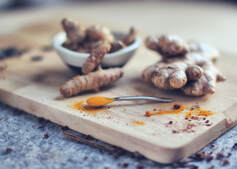
In other cultures, and eras, around the world, people used food as medicine. In our North American culture and the society in which we live, we live on the opposite end of the spectrum, and instead of eating foods with medicinal qualities, we eat foods of convenience, that are processed and packaged, nutrient-depleted, and often chemical/ preservative/ and sugar-laden. One could argue, I would! that these would be best not even considered foods! And rather than promote health, they negate health.
I love experimenting with different superfoods and herbs and spices in my cooking, and doing what I can to return my way of living and eating to one where I am getting health benefits from what I am consuming. For my article this month, I decided to profile a super food that I have been thoroughly enjoying consuming, in multiple different forms: ginger root!
Originally from China, ginger has been in use for ages. It is known as a spice and an herb for its culinary, nutritional and health properties. Ginger looks like a knobby fibrous root with smooth light brown skin. Its flesh is white when you peel it – although it tends to turn pink when marinated (which is served with sushi). The plant itself grows up to four feet tall and has a bamboo-like appearance. It blooms aromatic yellow or green flowers with purple streaks.
Ginger is a yummy seasoning in sweets, including cakes, cookies, breads and beverages. Its slightly hot, citrus-like flavour makes any dish taste special, particularly in sauces, marinades and soups. Ginger is very low in cholesterol and sodium. It’s a good source of dietary fibre, vitamin E, vitamin B6, iron, magnesium, potassium and selenium, and a very good source of manganese.
Ginger supports healthy digestion, stimulates gastric juices, and helps treat abdominal bloating, vomiting and diarrhea. Ginger also enhances natural resistance for colds and flu. Ginger mixed with honey is an efficient expectorant, giving relief from cough, cold, sore throat and runny nose. Ginger is also recognized for reducing inflammation in joint diseases, such as arthritis and rheumatism.
You’ll find ginger in the form of capsules, tea, powder, oil and even dried (and candied), depending on intended usage. When buying it fresh, look for ginger root with the least number of knots and/or branching. It should be kept in a cool, dry place, usually at 6 to 7 C. It may be refrigerated in plastic wrap for a couple of weeks or frozen for up to three months.
I am including some of my favourite recipes that incorporate this medicinal root.
READ ON FOR RECIPES
I love experimenting with different superfoods and herbs and spices in my cooking, and doing what I can to return my way of living and eating to one where I am getting health benefits from what I am consuming. For my article this month, I decided to profile a super food that I have been thoroughly enjoying consuming, in multiple different forms: ginger root!
Originally from China, ginger has been in use for ages. It is known as a spice and an herb for its culinary, nutritional and health properties. Ginger looks like a knobby fibrous root with smooth light brown skin. Its flesh is white when you peel it – although it tends to turn pink when marinated (which is served with sushi). The plant itself grows up to four feet tall and has a bamboo-like appearance. It blooms aromatic yellow or green flowers with purple streaks.
Ginger is a yummy seasoning in sweets, including cakes, cookies, breads and beverages. Its slightly hot, citrus-like flavour makes any dish taste special, particularly in sauces, marinades and soups. Ginger is very low in cholesterol and sodium. It’s a good source of dietary fibre, vitamin E, vitamin B6, iron, magnesium, potassium and selenium, and a very good source of manganese.
Ginger supports healthy digestion, stimulates gastric juices, and helps treat abdominal bloating, vomiting and diarrhea. Ginger also enhances natural resistance for colds and flu. Ginger mixed with honey is an efficient expectorant, giving relief from cough, cold, sore throat and runny nose. Ginger is also recognized for reducing inflammation in joint diseases, such as arthritis and rheumatism.
You’ll find ginger in the form of capsules, tea, powder, oil and even dried (and candied), depending on intended usage. When buying it fresh, look for ginger root with the least number of knots and/or branching. It should be kept in a cool, dry place, usually at 6 to 7 C. It may be refrigerated in plastic wrap for a couple of weeks or frozen for up to three months.
I am including some of my favourite recipes that incorporate this medicinal root.
READ ON FOR RECIPES

 RSS Feed
RSS Feed